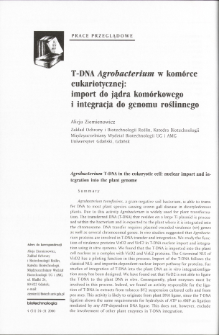
Obiekt
Tytuł: T-DNA Agrobacterium w komórce eukariotycznej: import do jądra komórkowego i integracja do genomu roślinnego
Inny tytuł:
Agrobacterium T-DNA in the eukaryotic cell: nuclear import and integration into the plant genome
Wydawca:
Komitet Biotechnologii PAN ; Instytut Chemii Bioorganicznej PAN
Abstrakt:
Agrobacterium tumefaciens, a gram-negative soil bacterium, is able to transfer DNA to most plant species causing crown gall disease in dicotyledonousplants. Due to this activity Agrobacterium is widely used for plant transformation. The transferred DNA (T-DNA) that resides on a large Ti plasmid is processed within the bacterium and is exported to the plant where it is integrated intothe chromosome. DNA transfer requires plasmid encoded virulence (vir) genesas well as several chromosomal genes. In vivo studies suggested that Agrobacterium proteins are involved in T-DNA transfer and integration. We study the function of virulence proteins VirD2 and VirE2 in T-DNA nuclear import and integration using in vitro systems. We found that the T-DNA is imported into the plantcell nucleus as a complex with VirD2 and VirE2 proteins. The C-terminal NLS ofVirD2 has a piloting function in this process. Import of the T-DNA follows theclassical NLS- and importin-dependent nuclear import pathway for proteins. Forstudies of integration of T-DNA into the plant DNA an in vitro integration/ligation assay has been designed. We have found out that VirD2 is not able to ligatethe T-DNA to the plant DNA in vitro. Consequently, plant enzymes must beinvolved in this process. Indeed, we found an activity responsible for the ligation of T-DNA in extracts from tobacco BY2 suspension cultured cells and frompea axes. This activity is likely to originate from plant DNA ligase, since the T-DNAligation shows the same requirements for hydrolysis of ATP to AMP as ligationmediated by any ATP-dependent DNA ligase. This does not, however, excludethe involvement of other plant enzymes in T-DNA integration.
Czasopismo/Seria/cykl:
Biotechnologia, vol.51, 4 (2000)-.
Tom:
Zeszyt:
Strona pocz.:
Strona końc.:
Szczegółowy typ zasobu:
Format:
Identyfikator zasobu:
0860-7796 ; oai:rcin.org.pl:140151 ; IChB B-47
Źródło:
Biblioteka Instytutu Chemii Bioorganicznej PAN
Język:
Język streszczenia:
Zakres czasowy:
Prawa:
Licencja Creative Commons Uznanie autorstwa-Na tych samych warunkach 4.0
Zasady wykorzystania:
Digitalizacja:
Instytut Chemii Bioorganicznej Polskiej Akademii Nauk
Lokalizacja oryginału:
Instytut Chemii Bioorganicznej Polskiej Akademii Nauk
Dofinansowane ze środków:
Dostęp:
Kolekcje, do których przypisany jest obiekt:
- Repozytorium Cyfrowe Instytutów Naukowych > Kolekcje Partnerów > Instytut Chemii Bioorganicznej PAN > Artykuły
- Repozytorium Cyfrowe Instytutów Naukowych > Piśmiennictwo > Czasopisma/Artykuły
Data ostatniej modyfikacji:
2 paź 2020
Data dodania obiektu:
21 wrz 2020
Liczba pobrań / odtworzeń:
344
Wszystkie dostępne wersje tego obiektu:
https://rcin.org.pl/publication/175597
Wyświetl opis w formacie RDF:
Wyświetl opis w formacie RDFa:
Wyświetl opis w formacie OAI-PMH:
| Nazwa wydania | Data |
|---|---|
| T-DNA Agrobacterium w komórce eukariotycznej: import do jądra komórkowego i integracja do genomu roślinnego | 2 paź 2020 |
Obiekty Podobne
Borkowska, Bożenna
Ziółkowski, Piotr Babula- Skowrońska, Danuta Kaczmarek, Małgorzata Cieśla, Agata Sadowski, Jan
Nowak, Jacek K.

 INSTYTUT ARCHEOLOGII I ETNOLOGII POLSKIEJ AKADEMII NAUK
INSTYTUT ARCHEOLOGII I ETNOLOGII POLSKIEJ AKADEMII NAUK
 INSTYTUT BADAŃ LITERACKICH POLSKIEJ AKADEMII NAUK
INSTYTUT BADAŃ LITERACKICH POLSKIEJ AKADEMII NAUK
 INSTYTUT BADAWCZY LEŚNICTWA
INSTYTUT BADAWCZY LEŚNICTWA
 INSTYTUT BIOLOGII DOŚWIADCZALNEJ IM. MARCELEGO NENCKIEGO POLSKIEJ AKADEMII NAUK
INSTYTUT BIOLOGII DOŚWIADCZALNEJ IM. MARCELEGO NENCKIEGO POLSKIEJ AKADEMII NAUK
 INSTYTUT BIOLOGII SSAKÓW POLSKIEJ AKADEMII NAUK
INSTYTUT BIOLOGII SSAKÓW POLSKIEJ AKADEMII NAUK
 INSTYTUT CHEMII FIZYCZNEJ PAN
INSTYTUT CHEMII FIZYCZNEJ PAN
 INSTYTUT CHEMII ORGANICZNEJ PAN
INSTYTUT CHEMII ORGANICZNEJ PAN
 INSTYTUT FILOZOFII I SOCJOLOGII PAN
INSTYTUT FILOZOFII I SOCJOLOGII PAN
 INSTYTUT GEOGRAFII I PRZESTRZENNEGO ZAGOSPODAROWANIA PAN
INSTYTUT GEOGRAFII I PRZESTRZENNEGO ZAGOSPODAROWANIA PAN
 INSTYTUT HISTORII im. TADEUSZA MANTEUFFLA POLSKIEJ AKADEMII NAUK
INSTYTUT HISTORII im. TADEUSZA MANTEUFFLA POLSKIEJ AKADEMII NAUK
 INSTYTUT JĘZYKA POLSKIEGO POLSKIEJ AKADEMII NAUK
INSTYTUT JĘZYKA POLSKIEGO POLSKIEJ AKADEMII NAUK
 INSTYTUT MATEMATYCZNY PAN
INSTYTUT MATEMATYCZNY PAN
 INSTYTUT MEDYCYNY DOŚWIADCZALNEJ I KLINICZNEJ IM.MIROSŁAWA MOSSAKOWSKIEGO POLSKIEJ AKADEMII NAUK
INSTYTUT MEDYCYNY DOŚWIADCZALNEJ I KLINICZNEJ IM.MIROSŁAWA MOSSAKOWSKIEGO POLSKIEJ AKADEMII NAUK
 INSTYTUT PODSTAWOWYCH PROBLEMÓW TECHNIKI PAN
INSTYTUT PODSTAWOWYCH PROBLEMÓW TECHNIKI PAN
 INSTYTUT SLAWISTYKI PAN
INSTYTUT SLAWISTYKI PAN
 SIEĆ BADAWCZA ŁUKASIEWICZ - INSTYTUT TECHNOLOGII MATERIAŁÓW ELEKTRONICZNYCH
SIEĆ BADAWCZA ŁUKASIEWICZ - INSTYTUT TECHNOLOGII MATERIAŁÓW ELEKTRONICZNYCH
 MUZEUM I INSTYTUT ZOOLOGII POLSKIEJ AKADEMII NAUK
MUZEUM I INSTYTUT ZOOLOGII POLSKIEJ AKADEMII NAUK
 INSTYTUT BADAŃ SYSTEMOWYCH PAN
INSTYTUT BADAŃ SYSTEMOWYCH PAN
 INSTYTUT BOTANIKI IM. WŁADYSŁAWA SZAFERA POLSKIEJ AKADEMII NAUK
INSTYTUT BOTANIKI IM. WŁADYSŁAWA SZAFERA POLSKIEJ AKADEMII NAUK


































